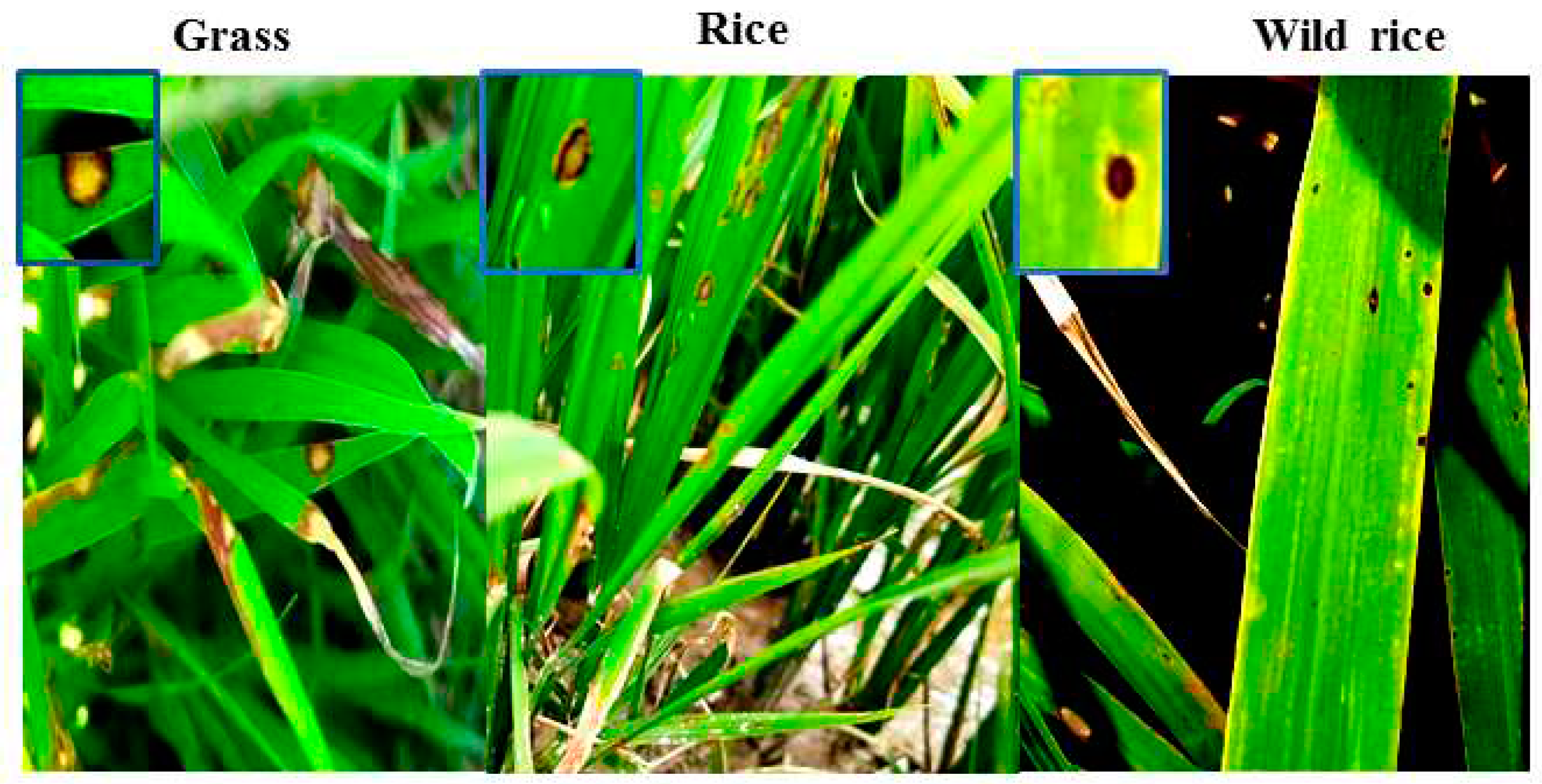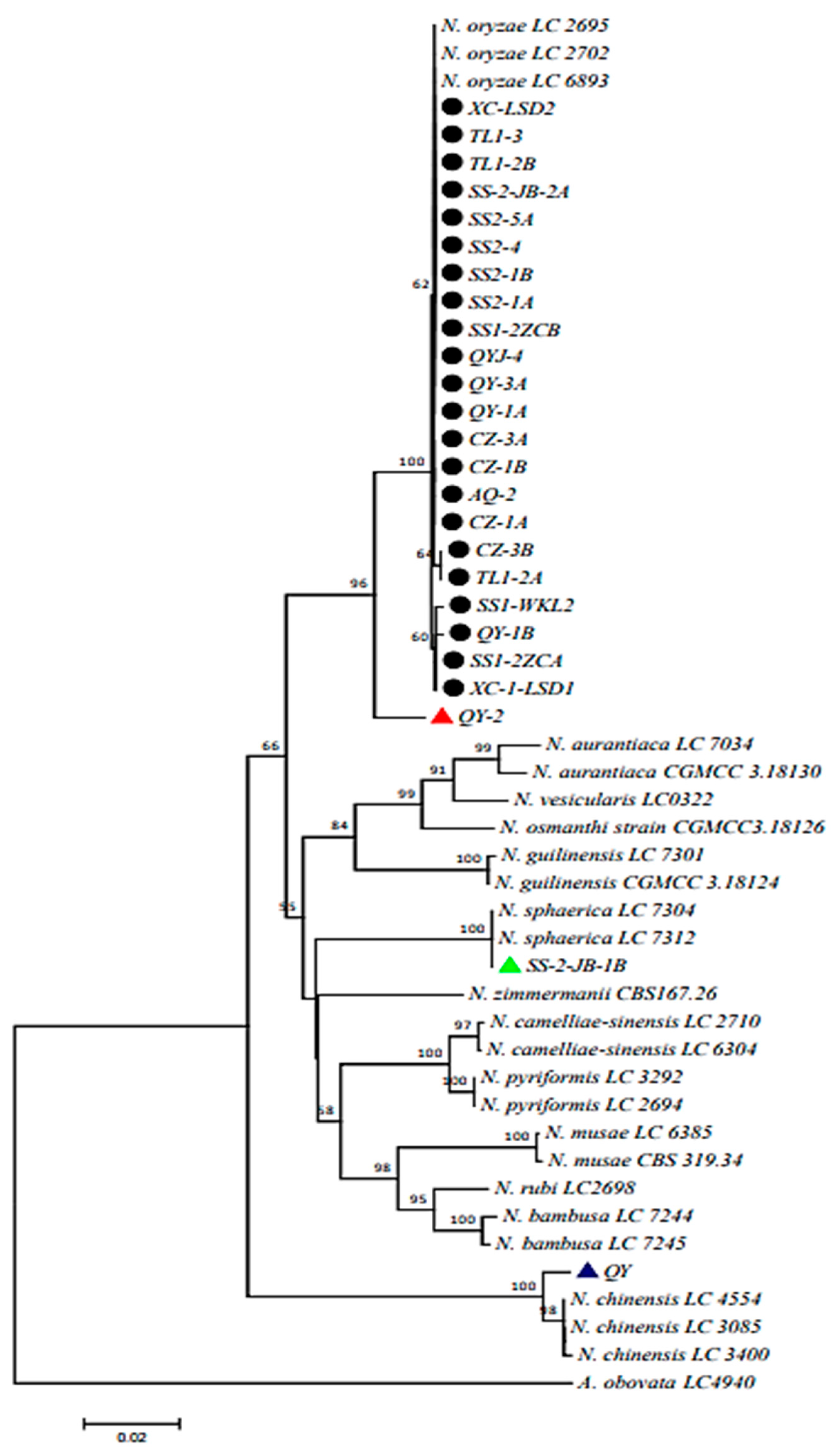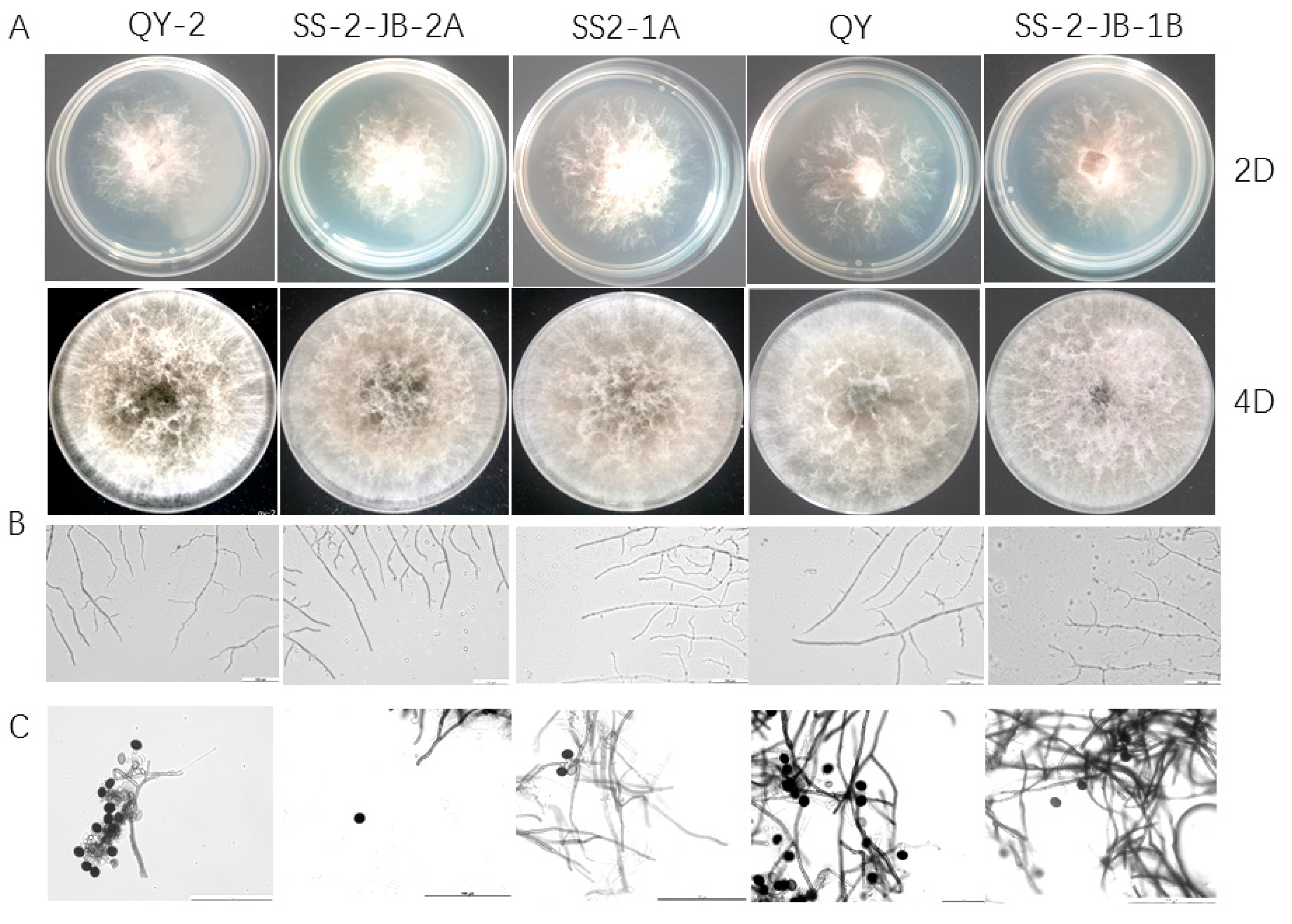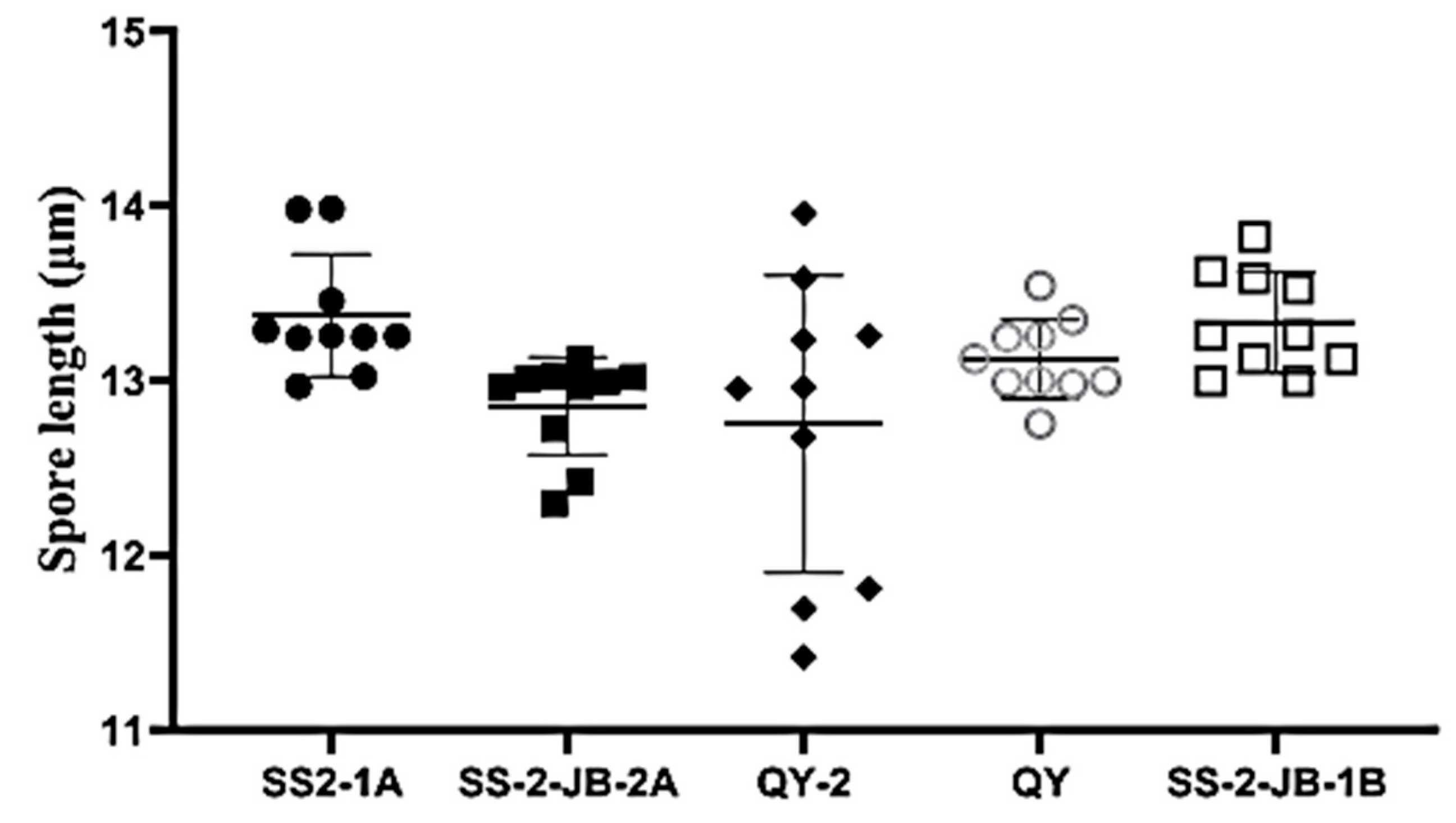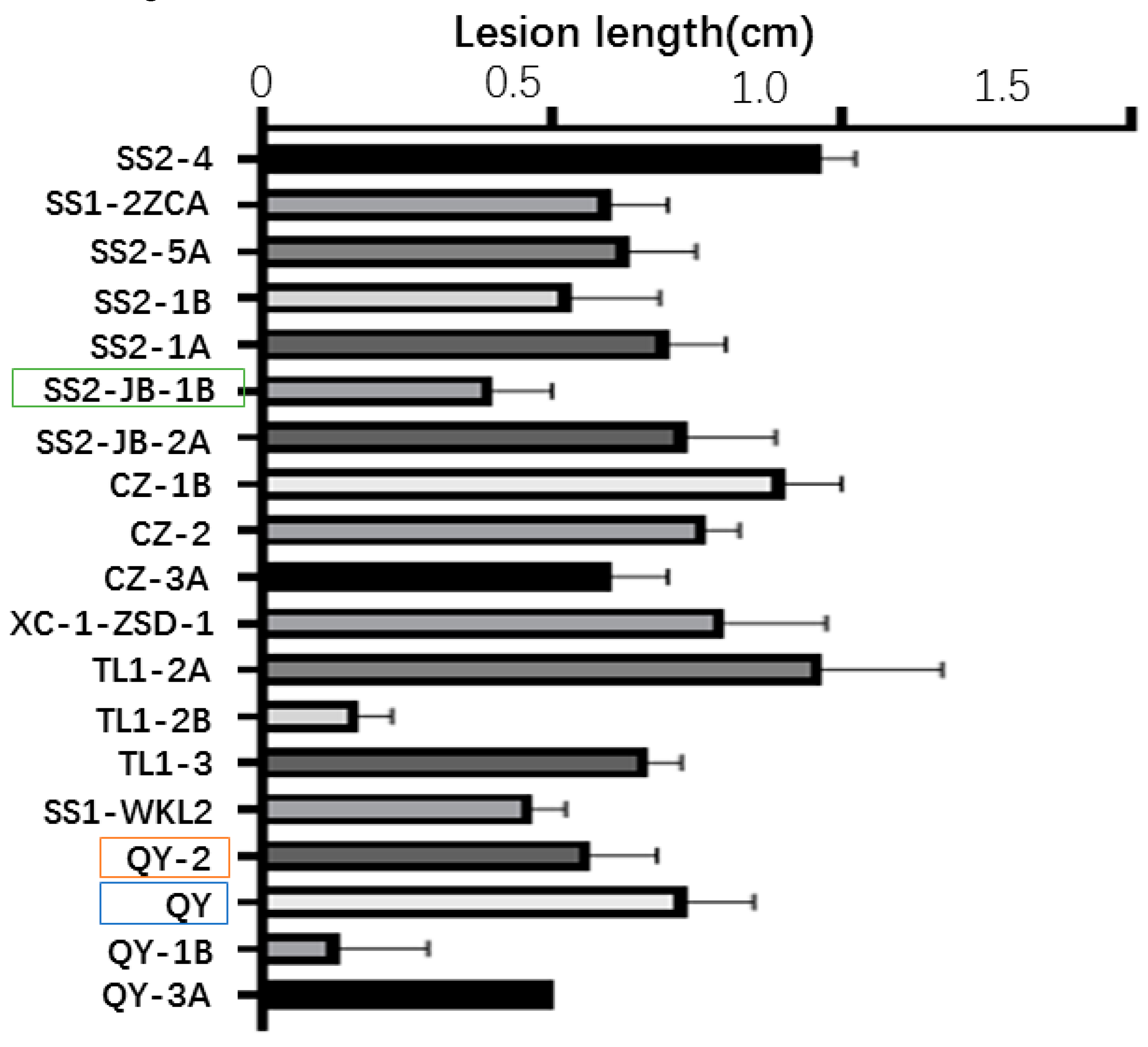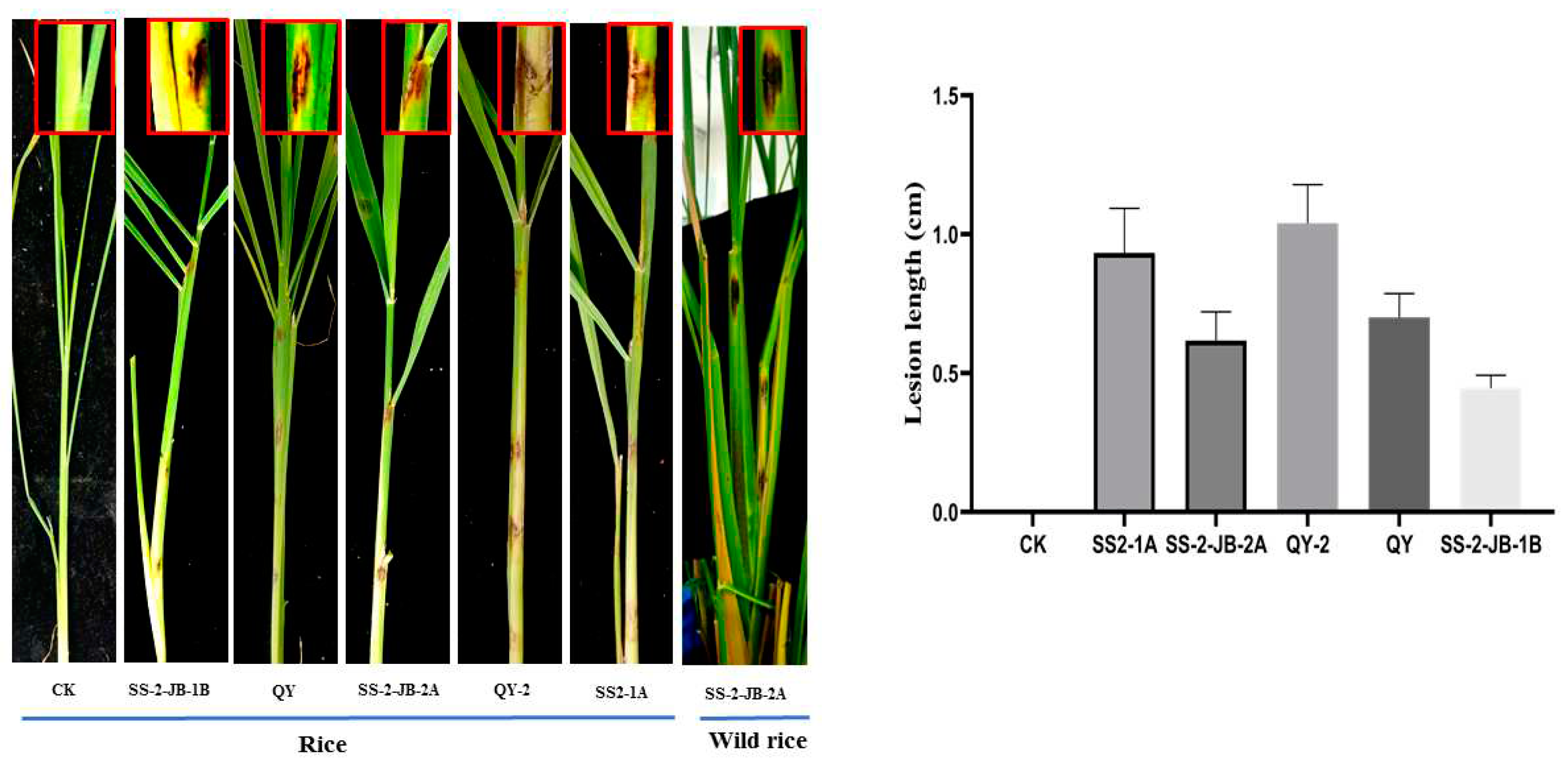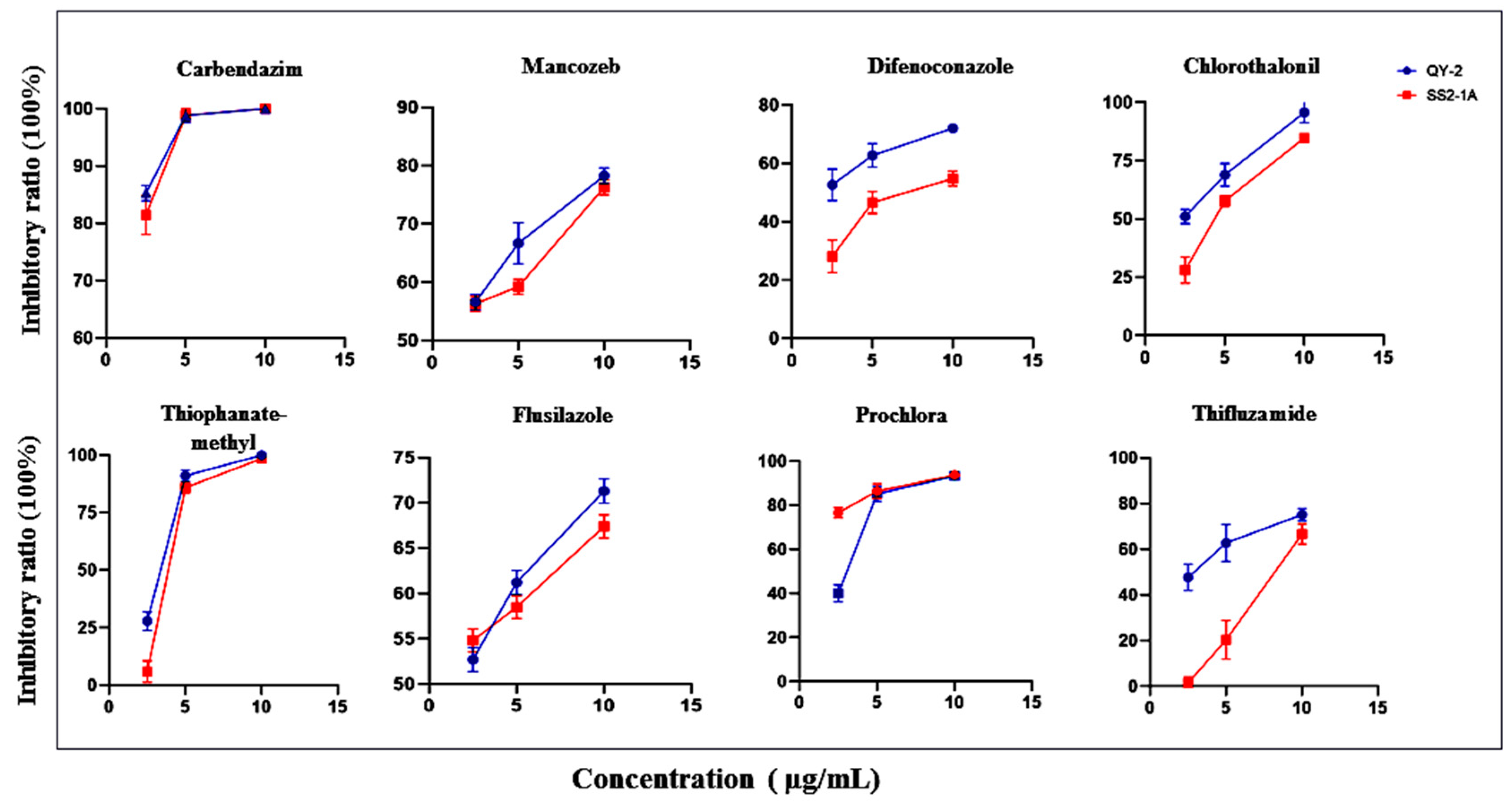1. Introduction
Nigrospora species are ascomycetes and include both endophytic and parasitic fungi that are becoming more and more famous [
1,
2,
3,
4]. This group of fungi can infect a wide range of plants, thereby causing great economic losses in crop production [
2,
3,
5,
6,
7,
8,
9,
10].
Nigrospora species are known to infect yam [
6], rice [
11],
Chrysanthemum moratorium [
3], passion fruit [
12,
13], peanut [
14], tobacco [
15] and
Photinia serrulata [
16] in China, and lead to leaf spot or blight symptoms. They seem to have a broad host range. The known rice pathogen
Nigrospora oryzae, for example, can also infect yam, wild rice, poplar, kiwifruit, red elephant grass,cotton and pear [3,6,9,11,17-20]. In light of the global temperature increase,
Nigrospora species will likely cause more and more plant diseases. Thus, the threat caused by
Nigrospora species should be drawing our attention and more knowledge about these pathogens should be gained.
Initially, characterization of
Nigrospora species was based on morphological features, and species identification was done by sequence comparison of the internal transcribed spacer (ITS) region [
2,
5,
9,
21]. However, among the members of this species there are very few morphological differences that are limited to differences in colony color, spore size and spore color [
21]. Recently, multi-locus analysis was used for the identification of fungal species. According to an analysis based on a multi-locus phylogenetic tree that was constructed using the combined ITS, TEF1-α, and TUB2 sequences,
Nigrospora species were divided into sixteen groups including the famous rice pathogen
N. oryzae, and two unclear groups [
2,
5,
6,
7,
21]. This analysis also led to the identification of many new species [
10,
22]. Therefore, species identification based on the multi-locus sequence analysis is more reliable, and will be especially beneficial for the characterization of
Nigrospora species with no special morphological features.
N. oryzae,
Nigrospora panici and
Nigrospora chinensis are all known to inhabit rice leaves as endophytes [
23]. However,
N. oryzae is also known as a rice pathogen that causes yellow-to-brown, oval or circular lesion with a large yellow halo on rice leaves [
11], and that is universally distributed on various plants or dead plant residues in the field. Initially, many of the
Nigrospora species were classified as
N. oryzae because of the high similarity of their ITS sequences [
23]. Therefore, many identified isolates of
N. oryzae are probably not completely accurately classified. The correct species identification of rice pathogens is a prerequisite for the successful development of novel rice disease-control strategies.
The provinces along the Yangtze River are important rice production regions in China. Especially in the Anhui province, where the weather is suitable for fungal growth and transmission, there is an abundant fungal biodiversity. Recently,
Nigrospora species were discovered to cause leaf spot disease on rice [
11]. However, there is little known about this species in the cities along the Yangtze River in the Anhui province. In this study, we have investigated rice and wild-rice leaf spot diseases in six cities of the Anhui province. Following the collection of diseased rice samples with oval or circular lesions, a molecular analysis was performed. This revealed the discovery of three novel rice pathogens in addition to the known
N. oryzae:
Nigrospora sphaerica,
Nigrospora chinensis, and a new species,
Nigrospora anhuiensis. 2. Materials and Methods
Sample collection of diseased leaves and pathogen isolation
For sample collection, we screened at least five rice fields (each fields >1,000 acres) each at 17 sites near different cities in the Anhui province along the Yangtze River during the rice production season from June to October 2021. Instances of rice leaf spot disease were recorded and samples of diseased rice leaves were collected. We also screened and sampled the wild rice and grasses nearby the rice fields. To isolate fungal plant pathogens, collected detached leaves were surface-sterilized by75% ethanol for 30 s and 0.5% sodium hypochlorite for 5 min, then three rinses in sterile distilled water, dried, cut in 0.5-cm stripes and placed on potato dextrose agar (PDA) containing kanamycin (50 mg/L). Individual isolates were sub-cultured three times on kanamycin-containing PDA. Fungal morphology was recorded by photography after two and four days of incubation at 25°C.
Phylogenetic analysis of fungal isolates
Mycelia of fungal isolates were scraped off from PDA plates that were incubated for 2 days at 25°C. The material was collected and used for genomic DNA isolation [
24]. The ITS, TEF1, and TUB2 sequences of the isolates were amplified using primer pairs according to a previous study [
21]. PCR products were sent for sequencing by the Sangon Company (Shanghai). The newly generated sequences were complemented with the ITS, TEF1, and TUB2 sequences from different
Nigrospora species available in the NCBI nucleotide data base [
21]. Nonsense sequences were removed from 5’ and 3’ flanks prior to sequence alignment using MEGA7.0 [
25]. The phylogenetic tree was generated using the neighbor joining method with 1000 bootstrap replicates with the MEGA7.0 software [
25]. ITS, TEF1 and TUB2 sequences of the new
N. anhuiensis isolate were submitted to the NCBI database.
Virulence testing of fungal isolates
For testing virulence of fungal isolates on rice, the fungal strains were firstly cultured on PDA for two days. Agar plugs from fungal colony edges were excised from the plates and positioned on detached leaves of one-month-old rice seedlings, or on one-month-old rice seedlings grown under natural conditions in the summer. The inoculated detached rice leaves were incubated at 25°C for two days, at which lesions were observed, and lesion sizes were measured. Each strain was used to inoculate at least three leaves. Lesion sizes occurring on the inoculated seedlings grown under natural conditions were observed at one week post inoculation. Three seedlings were inoculated per fungal strain.
Analysis of morphological features of the isolate QY-2
To observe morphologic similarities and differences of the isolate QY-2 with N. oryzae, N. sphaerica SS-2JB-1B, or N. chinensis QY, all strains were freshly grown on PDA medium and colony features were observed at two and four days incubation. To observe the features of individual hyphae, we cultured the strains for 24 h on PDA that was spread on sterile microscopic slides, and imaged the hyphae using bright light of fluorescent inverted microscope (Leica, Germany). We induced conidia formation of the five strains by cultivation on carrot agar (200 g fresh carrot soup in 1 L water, plusing 15 agar powder) at 25°C for seven days. Conidia were collected from the agar plates and analyzed using microscopy (Leica, Germany).
Sensitivity testing of N. anhuiensis QY-2 to eight different fungicides
To test sensitivity of N. anhuiensis QY-2 to commercial fungicides, we selected the eight fungicides chlorothalonil, carbendazim, thifluzamide, flusilazole, thiophanate-methyl, mancozeb, difenoconazole and prochloraz (Meilinxuehai, Nanjing, China) that are commonly applied in the field for fungal disease control. The QY-2 strain was cultured on the plates with different concentrations (0, 2.5, 5, and 10 µg/mL) of each fungicide, and N. oryzae strain SS2-1A was used as control. Colony diameters for each plate were measured and photographed at two days of incubation at 25°C. For each concentration, three technical replicates were prepared. Colony diameters were calculated using the formula Y= (Dn- D0) *100/D0, D0 indicates the colony diameter on PDA medium, and Dn means that on other fungicides containing plates.
3. Results
Nigrospora species are associated with leaf spot disease in the Anhui province, China
The Anhui province is one of the major rice-producing areas in China, located in the eastern part of the Yangtze River basin. To investigate incidences of rice disease in the Anhui province, we screened a total area of more than 17000 acres of rice fields and neighboring wild rice and grass plants. Incidences of rice disease in the form of circular or oval lesions on rice leaves were widely observed in Qingyang county, Nanling county and Guichi district, and a few incidences were found in Tongling City and Xuancheng City. Most of the samples were found in private rice fields, where the disease incidence was below 0.1%. In fields managed by companies or institutes, only very few diseased leaves were found. The diseased leaves showed leaf blight and brown to black circular, oval or fusiform lesions, which had a halo of yellow or brown color (
Figure 1). We isolated and purified leaf-colonizing fungi from diseased rice or wild rice leaves collected at various sites in the Anhui province, China, resulting in a total of 25 novel isolates (
Table 1).
A. Grass leaf spot disease in the rice field. B. Rice leaf spot symptoms. C. Wild rice leaf spot symptoms.
Isolate QY-2 is a novel Nigrospora species base on multiple genes-phylogenetic analysis
To allow species identification of the novel isolates, we amplified and sequenced their ITS, TEF1 and TUB2 genomic regions and used the obtained sequences for multi-locus phylogenetic tree construction after having added available reference sequences of different
Nigrospora species. Most (22 of 25) isolates clustered with known
N. oryzae strains and are thus identified as
N. oryzae isolates (
Figure 2; black ovals). One isolate (SS-2JB-1B) grouped with
N. sphaerica strains (
Figure 2; green triangle), one (QY) with
N. chinensis strains (
Figure 2; blue triangle), while one isolate (QY-2) located on a separate branch with high statistical score that was related to but clearly different from
N. oryzae (
Figure 2; red triangle). Thus, rice disease symptoms in the Anhui province could be associated to fungal isolates of
N. oryzae,
N. sphaerica,
N. chinensis, and a novel
Nigrospora spp. that is related to
N. oryzae. We named the novel
Nigrospora species that is represented by isolate QY-2 as
Nigrospora anhuiensis.
The ITS, TEF1, and TUB2 sequences from different Nigrospora species were downloaded from NCBI database, and the sequences of the isolates in this study were sequenced by the Sangon Company (Shanghai). All the three sequences for each strain were combined together to generate a long sequence, and blasted these all the long sequences using blastW2. The phylogenetic tree was generated through the neighbor joining method with 1000 bootstrap replicates, using MEGA 7.0. The isolates of this study are marked on the tree (black oval, N. oryzae isolates; red triangle, N. anhuiensis isolate; green triangle, N. sphaerica isolate; blue triangle, N. chinensis isolate). Size marker shows.
The new Nigrospora anhuiensis isolate QY-2 has similar morphologic features as other Nigrospora species
We aimed to observe whether the new
N. anhuiensis isolate QY-2 could be morphologically differentiated from the well-characterized
N. oryzae rice pathogen. We included in our analysis for comparison the less closely related strains
N. sphaerica SS-2JB-1B and
N. chinensis QY.
N. anhuiensis QY-2 formed a white colony with few aerial mycelia at 2 days incubation on nutrient agar, which is similar to that of
N. oryzae strains (
Figure 3A). At four days incubation, the
N. anhuiensis QY-2 colony center changed its color to dark green and the colony formed massive white aerial hyphae (
Figure 3A). In contrast, the colony color of the two
N. oryzae strains was palm green or brown, and the massive aerial mycelia formed were grey (
Figure 3A).
N. sphaerica SS-2JB-1B and
N. chinensis QY strains also produced grey aerial mycelia, but the morphology of the aerial mycelia was different from that of the other three strains (
Figure 3A). All investigated strains formed smooth, branched, and septate hyphae (
Figure 3B). Conidia formation of all strains could be induced on carrot medium. Conidia of all investigated strains had a similar globose or oval, black, smooth and aseptate morphology (
Figure 3C). The sizes of the conidia varied slightly among the strains. For
N. anhuiensis QY-2, conidia diameter was on average 12.75 µm but varied by 3 µm between the smallest and the largest measured conidium. Conidia of the
N. oryzae strains were on average 12.90 and 13.40 µm but varied only by 1 µm between the smallest and the largest measured conidium. (
Figure 4). The conidia of
N. sphaerica SS-2JB-1B and
N. chinensis QY were 13.1 and 13.3 µm on average with a 1-µm range between the smallest and the largest measured conidium (
Figure 4). Based on morphological criteria,
N. anhuiensis can best be differentiated from
N. oryzae,
N. sphaerica, and
N. chinensis by its dark green colony center color at four days of incubation on nutrient agar. However, we recommend species identification by multigene sequencing.
The ITS, TEF1, and TUB2 sequences from different Nigrospora species were downloaded from NCBI database, and the sequences of the isolates in this study were sequenced. All the three sequences for each strain were combined together to generate a long sequence, and blasted these all the long sequences using blastW2. The phylogenetic tree was generated through the neighbor joining method with 1000 bootstrap replicates, using MEGA 7.0. The isolates of this study are marked on the tree (black oval, N. oryzae isolates; red triangle, N. anhuiensis isolate; green triangle, N. sphaerica isolate; blue triangle, N. chinensis isolate). Size marker shows.
The length of the conidia was measured with the scale using a microscopy imaging system (Leica, Germany). Th graph was drawn using Prism GraphPad 8.0[
29].
The identified N. oryzae, N. sphaerica, N. chinensis and N. anhuiensis isolates are rice pathogens
To check whether the isolated strains were rice pathogens, we performed a virulence test on detached rice leaves. Because some of the isolates were collected in the same field and also are
N. oryzae isolates, we selected 16 isolates including most of
N. oryzae strains for virulence testing. Nineteen of 25 isolates were able to induce black spot lesions on detached rice leaves (
Figure 5). This included two strains that were isolated from wild rice, and the identified
N. sphaerica,
N. chinensis and
N. anhuiensis isolates (
Figure 5).
Isolates were grown on PDA for 2 days. Then the fungal agar plugs from the colony rim were inoculated on the 6 weeks old rice leaves. Lesion size was measured at 2 DPI. The lesion length data was analyzed and the graph drawn using Prism GraphPad 8.0 [
29].
To test whether the isolates were able to cause disease on plants cultivated in the field, we performed a virulence test on rice and wild-rice seedlings that were inoculated with either
N. oryzae strains SS2-1A, SS-2-JB-2A,
N. sphaerica strain SS-2JB-1B,
N. chinensis strain QY, or
N. anhuiensis strain QY-2. The inoculated rice seedlings were incubated in natural conditions in the summer. All strains induced lesions on healthy rice plants. Lesion length was largest with
N. anhuiensis strain QY-2, and
N. sphaerica strain SS-2JB-1B induced the smallest lesions (
Figure 6). The lesions caused by
N. anhuiensis strain QY-2 were brown to black and irregular, while the
N. sphaerica strain SS-2JB-1B and the
N. chinensis strain QY caused fusiform lesions with yellow verges (
Figure 6). These symptoms were similar to the symptoms in the field. We re-isolated the fungi from the lesions, and the colony features were the same to those of the strains used for infection. In summary, we conclude that the
N. sphaerica,
N. chinensis and
N. anhuiensis isolates are the agents that caused rice or wild rice leaf spot disease.
The fungal agar plugs were inoculated on the straw of the six weeks old rice leaves, and water as the control (CK). The rice plants were cultured in the natural conditions. Pictures were taken at 7 days post inoculation. The lesion length data was analyzed and imaged using Prism GraphPad 8.0[
29].
Sensitivity of N. anhuiensis strain QY-2 to various fungicides
To investigate whether the newly identified rice pathogen
N. anhuiensis can be killed by commercial fungicides, we tested the eight fungicides chlorothalonil, carbendazim, thifluzamide, flusilazole, thiophanate-methyl, mancozeb, difenoconazole and prochloraz that have already been registered in China for their capacity to inhibit growth of
N. anhuiensis strain QY-2 and
N. oryzae stain SS2-1A on nutrient agar plates. We observed that all eight tested fungicides could inhibit mycelial growth of both strains in a concentration-dependent manner (
Figure 7). For most fungicides,
N. anhuiensis strain QY-2 was more sensitive than
N. oryzae stain SS2-1A (
Figure 7). Carbendazim was the most effective fungicide against
N. anhuiensis strain QY-2, with a concentration of 5 µg/mL suppressing its growth almost completely (
Figure 7).
N. anhuiensis strain QY-2 could still grow on plates containing 10 µg/mL of thifluzamide, flusilazole, mancozeb, and difenoconazole, which suggests that these fungicides might be less effective in eradicating an infection with
N. anhuiensis in the field (
Figure 7). At lower fungicide concentrations, the colony diameter of
N. oryzae stain SS2-1A was dramatically bigger than that of
N. anhuiensis strain QY-2 for the fungicides difenoconazole, chlorothalonil, thiophanate-methyl, and thifluzamide, suggesting that
N. oryzae stain SS2-1A was more resistant to these fungicides (
Figure 7). Taken together, these data imply that the
N. anhuiensis strain QY-2 is sensitive to all tested fungicides. However, growth of the strain
in vitro can be effectively inhibited by carbendazim that might be the best choice for controlling
N. anhuiensis rice spot disease spread in the field.
The N. oyrzae (as the control) isolate SS2-1A and N. anhuiensis isolate QY-2 were cultured on the PDA plates adding different fungicides (carbendazim, mancozeb, difenoconazole, chlorothalonil, thiophanate-methyl, flusilazole, prochlora, and thifluzamide) for 2 days in 25°C incubator. The colony diameter was recorded and the data visualized using GraphPad Prism 8.0 software [
29].
4. Discussion
This study was conducted to identify the diversity and number of
Nigrospora species prevailing in infected rice fields in China. Leaf spot symptoms were observed in rice fields, that were similar to those observed in other studies i.e. brown to black fusiform-shaped lesions on leaves, branches and pedicles [
11]. In contrast to previous observations, the lesions observed in this study were surrounded with a yellow halo.
Nigrospora species were initially considered as endophytic fungi [
26,
27] but were recently considered as the causal agent of leaf rot disease on rice plants [
11]. Since then, many
Nigrospora species were identified as potential pathogens of new plant diseases on various host plants in different regions. This indicates that
Nigrospora species may threaten crop production.
Identification of the isolated strains solely based on morphological characters does not seem to be reliable. We conducted ITS, TEF1 and TUB2 multigene-based identification [
11] and phylogeny analysis which resulted in reliable species identification. In our study, a total of twenty-five strains of
Nigrospora species were isolated from diseased leaf specimens collected from rice fields. Multigene phylogenetic analysis [
11] showed that they belonged to
N. oryzae,
N. sphaerica,
N.
chinensis, and a new species that we named
N. anhuiensis. This shows that multigene phylogenetic analysis is a reliable and powerful method to differentiate morphologically difficult to identify fungal isolates.
Among the recovered species, we most often found N. oryzae that is a well-known rice pathogen causing leaf spot disease. However, we also isolated three additional species that were not known to be associated with leaf spot disease on rice, N. sphaerica, N. chinensis, and the newly identified species N. anhuiensis. We experimentally showed that all strains were able to infect rice plants and cause spot lesions on the rice leaves and stalks. These results imply that rice leaf spot disease is not only caused by N. oryzae but also by N. sphaerica, N. chinensis and N. anhuiensis.
The QY-2 isolate also has small size conidia ranging from 11 to 14 µm (
Figure 3), while the conidia size of
N. oryzae strains are bigger than 12 µm [
11,
17]. Because the conidia size generally is a special feature for the species identification. Moreover, the phylogenetic tree also showed that QY-2 were classified into a single clade, suggesting it should belong to a new species, named
N. anhuiensis QY-2, which are close to
N. oryzae. We confirmed pathogenicity of
N. anhuiensis QY-2 following Koch’ postulates [
28], thereby having proven that
N. anhuiensis is a causal agent of rice spot disease. However, our analysis showed that the strain is more sensitive to most tested fungicides than
N. oryzae SS2-1A, suggesting that it can be easily controlled by general fungicides.
